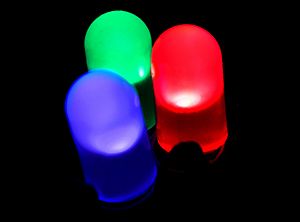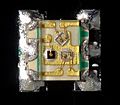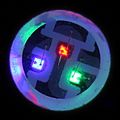Light-emitting diode facts for kids
A light-emitting diode (LED) is a semiconductor device that produces light from electricity. LEDs last a long time and do not break easily (compared to incandescent lightbulbs). They can produce many different colors. They are efficient - most of the energy turns into light, not heat.
An LED is a type of diode that makes one color of light when electricity is sent through it in the expected direction (electrically biased in the forward direction). This effect is a kind of electroluminescence.
The color of the light depends on the chemical composition of the semiconducting material used, and can be near-ultraviolet, visible or infrared. The color affects how much electricity is used by the LED. A white LED has either two or three LEDs inside, of different colors. Some white LEDs have one single-color LED inside (usually blue), combined with a phosphor that converts that single color to white.
LEDs are used in many places. They are the colored indicator lights on many electronic devices, they can be used to make bright advertising signs, brake lights on some newer cars, in TVs, and more recently, light bulbs for the home. White LEDs bright enough to illuminate rooms are usually more expensive than regular lightbulbs but they last longer and burn less electricity.
LEDs, which make their own light, should not be confused with LCDs, which block light. Some displays, however, mix the two technologies, using LEDs to backlight the LCD.
Today, some LEDs are surface-mount devices (SMD), so they can be very small.
Types
- Nikolay Zheludev 2007. The life and times of the LED – a 100-year history. Nature Photonics. 1, 189–192. [1]. [2] is a full-text version.
Images for kids
-
Blue LEDs
-
LEDs are produced in a variety of shapes and sizes. The color of the plastic lens is often the same as the actual color of light emitted, but not always. For instance, purple plastic is often used for infrared LEDs, and most blue devices have colorless housings. Modern high-power LEDs such as those used for lighting and backlighting are generally found in surface-mount technology (SMT) packages (not shown).
-
High-power light-emitting diodes attached to an LED star base (Luxeon, Lumileds)
-
Composite image of an 11 × 44 LED matrix lapel name tag display using 1608/0603-type SMD LEDs. Top: A little over half of the 21 × 86 mm display. Center: Close-up of LEDs in ambient light. Bottom: LEDs in their own red light.
-
Los Angeles Vincent Thomas Bridge illuminated with blue LEDs
-
A large LED display behind a disc jockey
-
LED panel light source used in an experiment on plant growth. The findings of such experiments may be used to grow food in space on long duration missions.
See also
 In Spanish: Led para niños
In Spanish: Led para niños
























